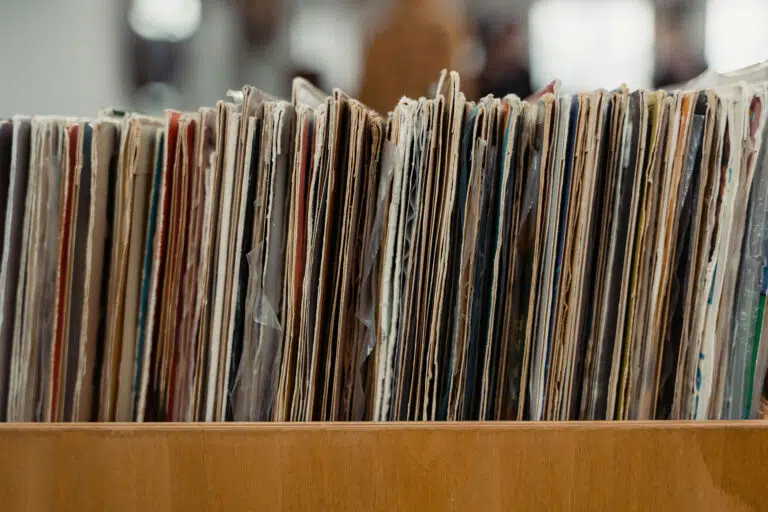Vinyl records are more popular than ever, and with that surge in interest comes plenty of old advice, half-truths, and collector stories that won’t go away. Whether it’s debates over colored vinyl sounding worse, shaped records being just for show, or the idea that original pressings are always better than reissues, these vinyl myths tend to spread fast.
Add in things like heavyweight 180g pressings, glow-in-the-dark variants, one-step mastering, and audiophile labels, and it’s easy to get overwhelmed by opinions that aren’t always rooted in fact. Based on insights shared by industry pros—those who cut, press, and remaster records—here are five common vinyl myths worth clearing up.
Why These Vinyl Myths Keep Hanging Around
Part of what makes vinyl so fun is how passionate the community is. Everyone’s got stories, preferences, and tips they swear by. But that’s also how myths stick around—especially when they get repeated in online forums, YouTube comments, or casual chats at the record shop. Some of it comes from outdated info, while other times it’s just personal taste being passed off as fact.
We’re not here to be gatekeepers, but if you’re spending money on vinyl—or just want to enjoy your records without second-guessing every detail—it helps to know what’s real and what’s just noise. Let’s look at five of the biggest vinyl myths floating around today and sort out what actually matters.
Myth 1: Black Vinyl Sounds Better Than Colored Vinyl
This is probably one of the most repeated myths in vinyl collecting. The idea is that black vinyl sounds better than colored or clear vinyl. But here’s the truth: black vinyl is just clear PVC (polyvinyl chloride) with black carbon dye added to it. In fact, the base material is naturally a milky white or clear.
Years ago, colored vinyl had a reputation for lower quality because the colorants weren’t well refined. Add in the fact that scratches were harder to spot, especially when sellers skipped play-testing, and that hurt colored vinyl’s image. But things have changed. Today’s chemical engineers are producing high-quality colored vinyl that can match the performance of black vinyl.
That said, not all colored vinyl is equal. Gimmicky pressings like glow-in-the-dark, glitter, or splatter vinyl may not hold up as well sonically. So while color itself isn’t the problem, all the extra stuff can be.
Myth 2: One-Step Vinyl Pressings Are Always Superior
One-step pressing sounds premium, right? The idea is that fewer steps between the lacquer and the final record means a purer, better-sounding record. In theory, yes—but in practice, it’s not always so clear.
In the one-step process, the lacquer is used to create a single stamper that presses directly into vinyl. But stampers wear out fast—often after just 1,000 pressings. If you want to press more, you have to cut a new lacquer. That means extra work, and inconsistency.
On the other hand, the traditional three-step process lets manufacturers create a “father,” “mother,” and multiple stampers—making it easier to press larger runs without losing quality.
Some engineers say they can’t really hear a difference. Others argue one-step records don’t even sound as good. So this myth? It’s still up for debate.
Myth 3: 45 RPM Records Always Sound Better Than 33 ⅓
This one’s mostly true—cutting a record at 45 RPM often leads to better sound. It allows engineers to cut wider grooves, which means more detail, better dynamics, and cleaner playback.
It’s not about the speed itself, but about the space. A 15-minute side cut at 45 RPM will usually sound better than the same music squeezed into 25 minutes at 33 ⅓ RPM. Less groove cramming means better fidelity.
But there’s a trade-off. You’ll need to flip the record more often and maybe pay a bit more. Whether that slight bump in quality is worth it depends on you.
While 45 RPM records can offer slightly better sound due to wider groove spacing, they also mean shorter playtime and more flipping. If you’re using an entry-level setup, you might not hear a huge difference—especially if your turntable isn’t optimized for both speeds. Check out our Best Turntables for Beginners guide if you’re just getting started.
Myth 4: Original Pressings Always Sound Better Than Reissues
We’ve all heard it: the original is best. But the truth is, not always. Modern reissues can sound just as good—sometimes better—thanks to improved mastering, better pressing plants, and high-quality source materials.
Every mastering decision is a trade-off. Boosting one part of the sound might weaken another. For example, adding more bass might dull the treble. And what sounds good on one system might sound harsh on another.
There are things to like about both versions. Some listeners might love the warmth of an original, while others appreciate the clarity of a new pressing. It’s personal—and it’s not always a win for the original.
Myth 5: You Don’t Need to Clean New Records
It’s tempting to unwrap a brand-new record and drop the needle straight away. But even new vinyl can benefit from a light cleaning.
Records pressed at high-quality plants often come out clean and static-free. Still, using a carbon fiber brush or a gentle anti-static solution can help, especially if the record picked up dust in packaging or shipping.
Ultrasonic cleaners can make even clean pressings sound better. But if you’re using a cleaning system with brushes that touch the grooves, you might want to skip that on brand-new records to avoid adding micro-abrasions.
New records aren’t always spotless—sometimes they come with factory dust or static cling. A quick brush or anti-static sweep usually does the trick. For deeper maintenance, our favorite record cleaning tools list has everything from brushes to affordable cleaning machines.
Bottom line: A light cleaning can help, but not all new vinyl needs a deep scrub.
Frequently Asked Questions About Vinyl Records
Does black vinyl sound better than clear or colored vinyl?
Not really. The sound quality has less to do with color and more to do with how the record was made. Black vinyl usually gets a cleaner reputation because it’s the industry standard, and the carbon black additive can help strengthen the material. But clear and colored vinyl can sound just as good if they’re pressed from high-quality masters using clean vinyl pellets. The real issue comes in when low-budget pressings cut corners on materials or QC—something that can happen with any color.
Is one-step vinyl always better than three-step pressing?
Not automatically. One-step pressings remove a few steps in the traditional record-making process, which can reduce surface noise and improve detail—but they’re also more fragile, and the pressings wear out faster. Three-step or traditional methods are more durable and consistent over a large batch. So while one-step records can sound incredible, the mastering, vinyl formulation, and who’s doing the cutting often matter more than how many steps were involved. It’s not always a straight upgrade—just a different approach.
Are 45 RPM records always better than 33 ⅓?
In terms of fidelity, yes—45 RPM records can hold more sonic detail because of the faster rotation speed. You’ll usually hear more clarity, separation, and low-end punch on a well-cut 45. But there’s a trade-off: they hold less music per side, so you’re flipping records more often, and they tend to be more expensive. For shorter albums, singles, or audiophile pressings, 45s can shine. But that doesn’t mean a 33 ⅓ LP is automatically worse—it depends on the source and the mastering.
Should I always clean a new vinyl record?
A quick dusting or anti-static brush is a good idea, especially if the record’s been sitting in a factory sleeve or shrinkwrap for months. But unless you notice visible grime or hear crackling right away, deep cleaning with fluids or vacuums isn’t always needed. Some new records come fairly clean out of the sleeve; others might have bits of paper or static cling. Trust your ears—if it sounds fine, don’t stress. Just avoid touching the grooves and store it properly to keep it clean.
Are original pressings better than reissues?
Not always. Original pressings can have a special vibe—especially if they were cut from the original analog masters—but some reissues actually improve on the original. New reissues might use fresher tapes, better mastering gear, or quieter vinyl formulations. Others might sound worse due to poor digital transfers or sloppy pressing. The key is to look at who mastered and pressed the record, and what source was used. Sometimes a reissue can blow the original out of the water, especially if the original was rushed or cheaply made.
Final Thoughts
Vinyl collecting is full of opinions, stories, and a fair amount of myth-making. Whether it’s about colored vinyl, pressing steps, or RPM speeds, there’s no single rule that fits every situation. What matters most is how the music sounds to you. Some collectors swear by original pressings, while others love the clarity of a clean, well-mastered reissue. Some avoid colored or shaped records entirely, while others collect them just for the fun of it.
And that’s part of the charm. The world of vinyl is personal—it’s about what you enjoy, not what others tell you is “right.” A lot of vinyl myths get passed around in forums or record shop chatter, but they don’t always hold up.
If you enjoy the ritual of dropping the needle, discovering old gems, or comparing different pressings of the same album, you’re already doing it right. Don’t stress too much over what’s “best.” Trust your ears, take care of your records, and let the myths stay where they belong—on internet forums and old message boards. Just enjoy the music.





